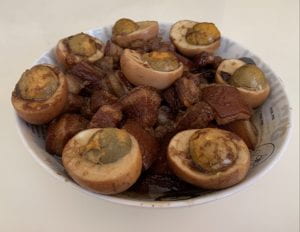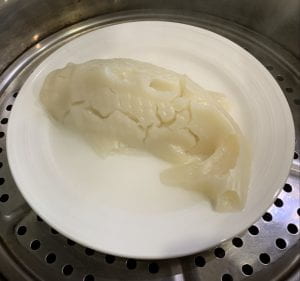General Information about Item:
- Genre: Material Lore – dish, recipe; Customary Lore – celebration, family tradition, superstition, historical story
- Language: Chinese (Mandarin)
- Country of Origin: China
- Informant: Y.Z.
- Date Collected: November 7, 2020
Informant Data:
- Y.Z. is about ~50 years old, and she currently resides in Shanghai, China. She was born in Beijing, China during the Cultural Revolution and grew up in relative poverty, as was the case with most Chinese families back then. After attending university in Beijing, she pursued her graduate studies in the US. She learned many traditional Chinese dishes from her mother and enjoys cooking for her family.
Contextual Data:
Historical & Cultural Context
- During the Yuan Dynasty (1279–1368) in China, the main currency was gold and silver ingots shaped like tiny boats called “yuán bǎo” (元宝). Many traditional Chinese New Year dishes such as dumplings are prepared in the shape of these ingots as a symbol for wealth and prosperity.
- In the 1960s and 1970s, China’s economy was in a terrible state. Meat, eggs, and sugar were heavily rationed. As a result, most families could not prepare meat dishes and desserts for their daily meals. During Chinese New Year, the rations were temporarily increased, so families would celebrate by making large meat dishes and fancy desserts.
Social Context
- Chinese New Year meals are always eaten as family. Most of the dishes have auspicious names, colors, or shapes that symbolize longevity, wealth, or good fortune. By eating these dishes, families express their hope for more prosperity and blessings in the coming year.
Item:
- Braised Pork and Gold Ingot Egg, or “hóng shāo ròu yuán bǎo dàn” (红烧肉元宝蛋) in Chinese, is a popular meat dish eaten for Chinese New Year, both in the northern and southern provinces. Diced pork belly is braised in a broth consisting of soy sauce, sugar, star anise, ginger, and garlic. Boiled eggs are then flavored using the remaining meat stock. Afterwards, the top half of the egg whites are removed to give the eggs a distinctive “yuán bǎo” (元宝) shape. Finally, the eggs are plated on top of the pork belly, and the family shares the dish together to express their wishes for the new year. There are several variations of this dish according to regional preferences. For example, in Shanghai, families tend to add much more sugar to the dish to give it a sweeter taste.
Image File:

The completed dish (Photo was taken by Y.Z. on November 7, 2020; she prepared the dish using a recipe from her mother.)
Translation of Interview Clip:
Y.Z. (informant): The dish I’m introducing is called “hóng shāo ròu yuán bǎo dàn” (红烧肉元宝蛋). Um, this dish, we always had it for Chinese New Year when I was a child. So, when I grew up in the 60s and 70s, China’s economy was pretty behind. Ingredients like pork and eggs were scarce resources, rationed every month by the government. For each person, every month, um, there was about one pound of meat and eggs in total. So, usually, we rarely had a chance to eat meat. That’s why during Chinese New Year, when the rations are slightly increased, we would use, um, pork and eggs to make the dish. One reason why this dish is so popular is because the meat is braised in soy sauce and other condiments, including star anise, scallion, ginger, and garlic… uh, the remaining meat stock is used to flavor the eggs and can also be saved for other dishes. The reason why the eggs are called ” yuán bǎo dàn ” (元宝蛋), is like this. “Yuán bǎo” (元宝), they are Chinese ingots, the shape is like a boat. During the Yuan Dynasty, gold and silver were used as currency, and they were molded into such a shape. ” Yuán” (元) refers to the Yuan Dynasty, and ” bǎo” (宝) means treasure. So in this dish, you can make the eggs resemble “yuán bǎo” (元宝) by removing part of the egg white. I guess this is a nice wish, the hope that, next year, life will be bountiful, the family income will increase, so people make this dish “hóng shāo ròu yuán bǎo dàn” (红烧肉元宝蛋). That’s about it. Are there any parts that you are not clear about?
W.W. (collector): Great, thanks for sharing. So I wanted to ask, is this dish a Beijing specialty or eaten widely across China?
Y.Z.: Uh, this is great question. This dish, I think it is eaten in many places, by many people. For Chinese New Year, both in the north and in the south, it is one of the most common dishes on the dinner table, suitable for young and old alike. Everyone likes it very much and eats the dish to show their wishes. Even though, the standards of living are higher now, and the dish can be made any time of the year, but as a tradition, many families still prepare it as a festival dish for Chinese New Year.
Collector’s Comments:
- I remember eating “hóng shāo ròu” (红烧肉), or braised pork, as a child, but this is my first time hearing about “yuán bǎo dàn” (元宝蛋). I am impressed by the level of creativity in the preparation of the eggs.
- Homeopathic magic is present in the superstitions related to the informant’s dish: eating the ingot-shaped eggs brings wealth and good fortune.
Collector’s Name: Winston Wang
Back to Main Page



